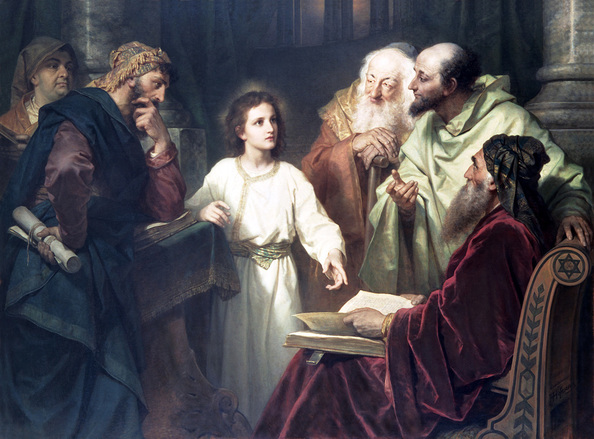Jesus in the Temple, 1881
Few scenes from the youth of Christ are so well known or beloved as Hofmann’s rendition of Luke 2: 46-47, Jesus in the Temple. Even Hofmann’s harshest critic judged this painting, “the most pleasing among the many representations of the subject.” Consequently, this painting’s continued popularity has led to a vast number of reproductions.
As with many of Hofmann’s paintings, the narrative is more significant than the representation of a historically accurate setting. Here, only the classical columns and Seal of Solomon on the chair suggest a temple location. Of greater interest are the figures’ physiognomies, gestures and how they interact with the “precocious” country boy from Nazareth.
Contrary to taking a cynical anti-Semitic approach to the Jewish figures, Hofmann’s elders are individuals the viewers can relate to and question their own spiritual sensitively. The ethereal beauty of the 12-year-old Christ contrasts markedly with the more corporeal, yet exquisitely painted, elders of the Jerusalem temple. In his lifetime many people questioned who the model was for this prodigy Christ. Hofmann responded, “When I read about Christ in the Bible, there arises spontaneously before my fancy a picture of Him which I try to retain and to reproduce-that is my only prototype." This vision of the Savior arose from an artistic and deeply devout mind.
Jesus in the Temple quickly found its place in the collection of one of Dresden’s foremost art museums. During the intensive bombing of Dresden during World War II the painting was moved into the countryside for preservation. After the war tastes had changed and the painting was not rehung.
by Angela Swanson Jones
Few scenes from the youth of Christ are so well known or beloved as Hofmann’s rendition of Luke 2: 46-47, Jesus in the Temple. Even Hofmann’s harshest critic judged this painting, “the most pleasing among the many representations of the subject.” Consequently, this painting’s continued popularity has led to a vast number of reproductions.
As with many of Hofmann’s paintings, the narrative is more significant than the representation of a historically accurate setting. Here, only the classical columns and Seal of Solomon on the chair suggest a temple location. Of greater interest are the figures’ physiognomies, gestures and how they interact with the “precocious” country boy from Nazareth.
Contrary to taking a cynical anti-Semitic approach to the Jewish figures, Hofmann’s elders are individuals the viewers can relate to and question their own spiritual sensitively. The ethereal beauty of the 12-year-old Christ contrasts markedly with the more corporeal, yet exquisitely painted, elders of the Jerusalem temple. In his lifetime many people questioned who the model was for this prodigy Christ. Hofmann responded, “When I read about Christ in the Bible, there arises spontaneously before my fancy a picture of Him which I try to retain and to reproduce-that is my only prototype." This vision of the Savior arose from an artistic and deeply devout mind.
Jesus in the Temple quickly found its place in the collection of one of Dresden’s foremost art museums. During the intensive bombing of Dresden during World War II the painting was moved into the countryside for preservation. After the war tastes had changed and the painting was not rehung.
by Angela Swanson Jones

